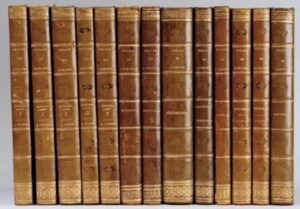On 26 September 2002, the London auction house Christie’s sold an archive described as ‘The Freycinet collection’. At the heart of the sale was a collection of first and early editions of publications and an impressive amount of the original artwork from the 1817-20 voyage of the Uranie and her successor, the Physicienne. There were also ten previously unrecorded and unpublished manuscript charts of Western Australia, New South Wales and Tasmania from the earlier Baudin expedition (1800 – 1804), on which Louis de Freycinet had served as a Lieutenant. All the material was originally from the Freycinet family collection, and some of the items bore the stamp ‘Bibliothèque de Laage Ex Libris Freycinet, but the sale was in London and was “by order of Richard England and Anthony Smith, liquidators of Southern Equities Corporation Limited … in association with Nevill Keating Pictures Ltd”. Clearly, the arrival of these items at Christie’s was a story in its own right.

Figure 1. Lot 19. of the Freycinet Collection, Louis de Freycinet’s own copy of the “Voyage autour du Monde,” sold in 2002 for £47,800. The collection also included a copy of the “Voyage de découvertes aux Terres Australes”, his report on the Baudin expedition, inscribed. ‘À Mon Père Hommage d’Amitié et de Respect L[ou]is. Freycinet’. The expected price for that item was between £5000 and £8000, but the winning bid was £14,340
What was that story? How did the Archive de Laage come to lose the Freycinet collection?
The loss, it seems, led almost to the disappearance of Archive itself, since it has no present-day presence on the internet, although Elaine Forrestal recorded that when she met Baron Henri de Freycinet in 2011 he gave her access to it. Even if much diminished, it seems that it still exists..The Freycinet family, however, having reached a high point of importance with Charles-Louis de Saulces de Freycinet (1828 – 1923), four times Prime Minister of the France during the Fourth Republic, declined thereafter. Charles was, moreover, out of the direct line of the baronetcy first granted to Henri, the eldest of the four de Freycinet brothers born in the late 1700s, being the son of the youngest brother, Casimir. The direct line from Henri, the first Baron Freycinet, continued through his son, Charles Henri Auguste (1823-1881) and into the second half of the twentieth century with Charles Henri’s son Henri Paul Louis Camille (1857-1954), but then passed to a junior branch, which evidently found it necessary, some yeas later, to sell many of the family papers and pictures. The collection that was auctioned in 2002 consisted of 98 lots, many of which consisted of more than one item. They did not, however, go directly from the Archive to Christie’s.
That part of the story was summarised in the pages of the Melbourne newspaper,The Age, on the day following the auction under the arresting heading “Art auction recovers some of Bond’s billions”. The Bond of this headline was Alan Bond, described in Wikipedia as “an English-born Australian businessman noted for his high-profile and often corrupt business dealings”. He was also notable as a collector of art and artefacts, his most remarkable venture into that field being his successful bid of just under $US54 million for van Gogh’s Irises, financed partly by a loan from Sotheby’s that was never repaid. At the time this was highest price ever bid for a single painting, and by those standards his Freycinet collection was small beer, realising a mere £1,570,403. This was, however, described by a Christie’s spokeswoman as “a very good result”, since none of the lots failed to reach their minimum estimated prices and many were sold for well above the maximum estimates. It was a result that must surely also have been welcomed by England and Smith, who were tasked with recovering as much as possible of the debt owed to creditors of Southern Equities, formerly the Bond Corporation, which was declared bankrupt in 1992, but it would not have made much of a dent in the missing $A 4 billion. The collection had been seized by Britain’s Serious Fraud Squad in 1995 in a raid on the London offices of the art dealers Nevill Keating, who had helped Bond assemble his art collection and then worked for the liquidators in seeking buyers. Unsurprisingly, and possibly to the benefit of all those interested in Louis de Freycinet and the voyage of the Uranie, there had been no single buyer amongst the Australian libraries and museums to whom the collection was first offered that could reach the reserve set for it as a whole. As a result, it was dispersed, but many of the institutional buyers, including the Mitchell Library of the State Library of New South Wales, have made items accessible on-line or physically in their libraries.
